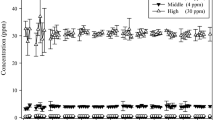Abstract
The inhalation toxicity of tertiary butylisonitril (TBIN) was evaluated in rats and mice. In addition, pregnant rats were exposed to TBIN aerosols to test its embryotoxic effects and male mice were exposed to TBIN aerosols to evaluate its mutagenic effects using the dominant lethal test.
Inhalation of TBIN aerosols caused death in rats only at high concentrations. The following inhalation LC50 values were determined for rats and mice following inhalation of TBIN aerosols: 4-hr exposure: male rats 715, female rats 710, male mice 377; five 4-hr exposures: male and female rats between 356 and 583 mg/m3 air. The animals were impaired for a long period of time, and death occurred up to 10 days after the exposure.
Female rats were exposed to TBIN aerosols from the 6th to the 15th day of gestation daily for 4 hrs. The used concentrations were not toxic to the pregnant rats. It became evident that only the lowest concentration (14 mg/m3) was not effective to the development of the fetus. A TBIN concentration of 36 mg/m3 definetely increased the resorption in embryos, and with 71 mg/m3 a complete loss of the fetus occurred due to resorption. A teratogenic effect could not be determined.
A single 4-hr inhalation of 125 mg TBIN/m3 air caused changes of the sperms of male mice. There was a decreased fertilization capability during the first week of mating after the exposure and a decreased implantation rate with a simultaneous increase of pre-implantation losses in the females.
With respect to industrial hygiene it is important that concentrations of TBIN in the air show embryotoxic and anti-spermatogenic effects in animals, which they tolerated without symptoms of poisoning.
Zusammenfassung
Die Toxicität von tertiärem Butylisonitril (TBIN) wurde nach dynamischer Inhalation an Ratten und Mäusen untersucht. Ferner erfolgten inhalationstoxikologische Untersuchungen an Ratten zur Prüfung auf embryotoxische Wirkungen und an Mäusen zur Prüfung auf mutagene Wirkungen im Dominant-Letal-Test nach Behandlung der männlichen Mäuse.
Die Einatmung von tert. Butylisonitril-Aerosolen wirkte bei Ratten erst in hohen Luftkonzentrationen letal. So betrugen bei der einmaligen, 4stündigen Exposition die LC50-Werte für männliche und weibliche Ratten 715 bzw. 710 mg/m3 und bei der 5mal 4stündigen Exposition zwischen 356 und 583 mg/m3. Mäuse waren empfindlicher als Ratten, bei der einmaligen 4stündigen Exposition betrug die LC50 für männliche Mäuse 377 mg/m3. Die Tiere waren lange Zeit geschädigt, und Todesfälle traten bis zu 10 Tagen nach der Exposition auf.
Im Embryotoxicitätsversuch wurden weibliche Ratten vom 6. bis 15. Tag der Trächtikgeit täglich für 4 Std verschiedenen, für die Muttertiere nicht toxischen Konzentrationen von TBIN ausgesetzt. Es zeigte sich, daß nur die niedrigste untersuchte Dosis, 14,8 mg/m3, schädigungslos für die Fruchtentwicklung war. Bei einer TBIN-Konzentration von 36 mg/m3 war die Resorption von Embryonen sehr deutlich gegenüber den Kontrollen erhöht, und bei 71 mg/m3 trat vollständiger Keimverlust durch Resorption ein. Eine teratogene Wirkung war nicht nachzuweisen.
Im Dominant-Letal-Test führte eine einmalige, 4stündige Inhalation von 125 mg TBIN pro m3 Atemluft bei Mäuseböcken zu einer Schädigung der Spermien, die sich in der 1. Paarungswoche nach der Exposition in einer herabgesetzten Befruchtungsfähikgeit und einer herabgesetzten Implantationsrate bei gleichzeitigem Anstieg des präimplantativen Verlustes bei den befruchteten Weibchen äußerte.
Gewerbehygienisch bedeutsam ist nach diesen Ergebnissen, daß tert. Butylisonitril in Konzentrationen, die symptomlos toleriert wurden, im Tierversuch die Keimlinge und die männlichen Samenzellen schädigen kann, nachdem es über die Atemwege in den Organismus gelangt ist.
Similar content being viewed by others
Literatur
Bateman, A. J.: The induction of dominant lethals in rats and mice with triethylene melamine (TEM). Genet. Res. (Camb.) 1, 381 (1960)
Bateman, A. J.: Mutagenic sensitivity of maturing germ cells in the male mouse. Heredity 12, 213 (1968)
Dilley, J., Doull, J.: Report of the University of Chicago, Department of Pharmacology. Chicago 37, Ill., 15. 6. 1961
Green, S., Palmer, K. A., Legator, M. S.: Effects of cyclohexylamine on the fertility of male rats. Fd. Cosmet. Toxicol. 10, 29 (1972)
Kimmerle, G., Eben, A.: Metabolism, excretion and toxicology of trichloroethylene after inhalation. 1. Experimental exposure on rats. Arch. Toxicol. 30, 115 (1973)
Kratochvilova, J.: Pre-implantation loss in the dominant lethal assay. Paper pres. at the 4th Ann. Meet., European Environmental Mutagen Society, Heidelberg, May 20–23, 1974
Krüger, J.: Statistical methods in mutation research. In: Chemical mutagenesis in mammals and man. F. Vogel and G. Röhrborn Eds., 460. Berlin-Heidelberg-New York: Springer 1970
Lorke, D.: Zur Methodik der Untersuchungen embryotoxischer und teratogener Wirkungen an der Ratte. Arch. exp. Path. Pharmak. 246, 147 (1963)
Lorke, D.: Embryotoxische Wirkungen an der Ratte. Arch. exp. Path. Pharmak. 250, 360 (1965)
Röhrborn, G.: Mutagenicity tests in mice. I. The dominant-lethal method and the control problem. Humangenetik 6, 345 (1968)
Röhrborn, G.: The activity of alkylating agents. I. Sensitive mutable stages in spermatogenesis and oogenesis. In: Chemical mutagenesis in mammals and man. F. Vogel and G. Röhrborn Eds., 294. Berlin-Heidelberg-New York: Springer 1970
Wilcoxon, F.: Individual comparisons by ranking methods. Biometric Bulletin 1, 80 (1945)
Author information
Authors and Affiliations
Rights and permissions
About this article
Cite this article
Kimmerle, G., Lorke, D. & Machemer, L. Inhalationstoxikologische Untersuchungen mit tertiärem Butylisonitril an Ratten und Mäusen. Arch Toxicol 33, 241–250 (1975). https://doi.org/10.1007/BF00311276
Received:
Issue Date:
DOI: https://doi.org/10.1007/BF00311276



